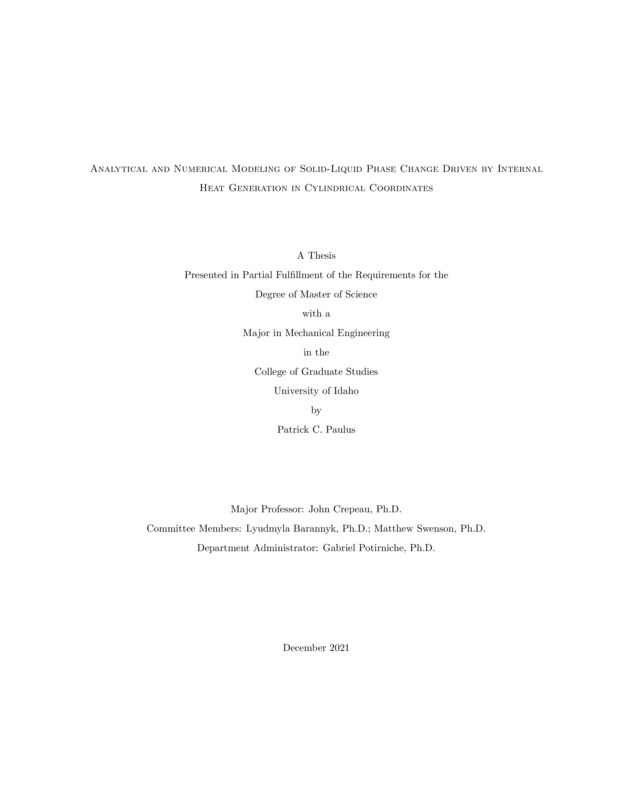Analytical and Numerical Modeling of Solid-Liquid Phase Change Driven by Internal Heat Generation in Cylindrical Coordinates
Paulus, Patrick. (2021-12). Analytical and Numerical Modeling of Solid-Liquid Phase Change Driven by Internal Heat Generation in Cylindrical Coordinates. Theses and Dissertations Collection, University of Idaho Library Digital Collections. https://www.lib.uidaho.edu/digital/etd/items/paulus_idaho_0089n_12180.html
- Title:
- Analytical and Numerical Modeling of Solid-Liquid Phase Change Driven by Internal Heat Generation in Cylindrical Coordinates
- Author:
- Paulus, Patrick
- Date:
- 2021-12
- Keywords:
- Heat Transfer Phase Change Stefan Problem
- Program:
- Mechanical Engineering
- Subject Category:
- Mechanical engineering
- Abstract:
-
The study of liquid-solid phase change has value in a range of applications, including in nuclear power.Nuclear fuel rods are subject to internal heat generation that, during extreme conditions, can result in the fuel becoming partially molten. Understanding of the melting process is critical to the safe design and operation of nuclear power plants. However, analytical work in this area is still limited. Two scenarios of liquid-solid phase change driven by internal heat generation are presented for a cylindrical domain: a case with Constant Surface Temperature (CST), and a case with Constant Surface Heat Flux (CSHF). We conducted an analysis of both scenarios in the form of the Stefan problem, a free boundary problem where the position of the interface between liquid and solid phases can change in time. By assuming constant thermal properties, pure conduction, and a sharp interface, we were able to use the superposition principle to derive closed-form, first-order ordinary differential equations with infinite series describing interface motion for one-dimensional, isothermal phase change. We compared our analytical models against numerical solutions generated through the commercial software Ansys Fluent. This software uses the enthalpy method, which allows the formation of a mushy zone, to solve for temperature, enthalpy, and liquid fraction in the problem domain. Using this model, we were able to check our solutions for mathematical soundness and evaluate the implications of assuming a sharp liquid-solid interface. We performed comparisons between the analytical and numerical models during both melting and solidification scenarios for several values of Stefan number for the CST case and several values of heat flux for the CSHF case. The CST case saw strong agreement in interface position in time for the slower phase change cases. However, during the melting scenarios for these slower speeds, we saw a divergence in temperature profiles characterized by a nonphysical overheating phenomenon at smaller time steps due to the formation of a mushy zone in the numerical model. This issue lessened with higher interface speeds and did not present itself during the solidification cases. Agreement in the CSHF cases was weaker than for the CST cases, with disagreement being most significant when the material was mostly solid. This disagreement was attributed largely to inaccuracy of the theoretical model. At faster phase change speeds, we saw more mushy zone development in the melting cases, with the solidification cases once again showing no mushy zone effects.
- Description:
- masters, M.S., Mechanical Engineering -- University of Idaho - College of Graduate Studies, 2021-12
- Major Professor:
- Crepeau, John
- Committee:
- Barannyk, Lyudmyla; Swenson, Matthew
- Defense Date:
- 2021-12
- Identifier:
- Paulus_idaho_0089N_12180
- Type:
- Text
- Format Original:
- Format:
- application/pdf
- Rights:
- In Copyright - Educational Use Permitted. For more information, please contact University of Idaho Library Special Collections and Archives Department at libspec@uidaho.edu.
- Standardized Rights:
- http://rightsstatements.org/vocab/InC-EDU/1.0/

